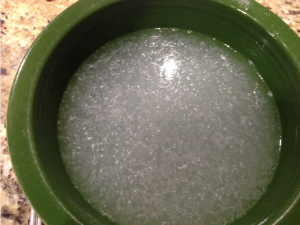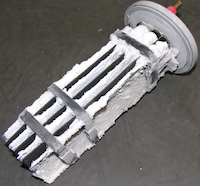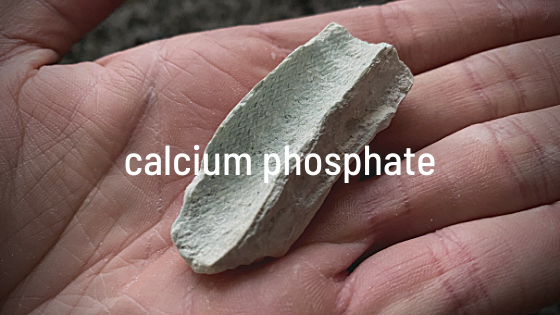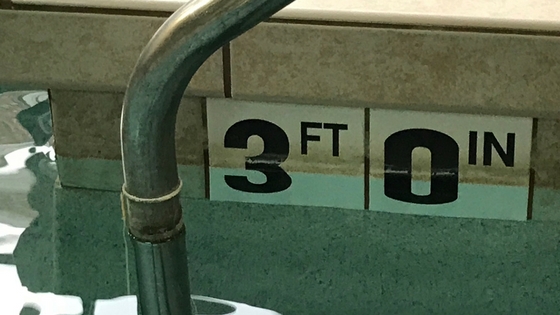Scum lines are very common in pools
In our business (commercial swimming pools), almost every pool has a scum line. Yes, even gutter pools can have them. For the sake of this article, let’s define a scum line as a visible layer of deposits at the water level that adhere to surfaces: walls, ladders, rails, tile lines or gutters. These deposits are not always the same. In fact, we find they are usually a mixture of non-living organics and anything that adheres to them. Because non-living organics in pools are often sticky and/or slimy, any number of suspended contaminants can join in on the scum line party.
We have seen hair, lint, grease, dirt, leaves, and other fun stuff adhered to pool walls at the water level. We have also seen deposits of calcium carbonate scale, calcium phosphate scale, and dried salt. This article will explain how and why scum lines form; and more importantly, how to prevent and remove existing scum lines.
Chlorine vs. Bather Waste

Figure 1. 100 parts-per-million chlorine in a bowl of water, versus a small amount of WD-40. It congealed into a hardened mess. Is chlorine really cut out for oxidizing oils and non-living organics? Surely 100 ppm should be enough to handle a small amount of oil. Right?
Non-living organic waste, or bather waste, comes in many forms. Body oils, sweat, mucous, urine…but also what we put on our bodies: lotions, hair products, sunscreen, etc. All of these contaminants contribute to the oxidant demand that chlorine must overcome to do its primary job: sanitation. Have you ever seen what chlorine does to a high concentration of bather waste? We experimented with 100 ppm chlorine in a bowl of water with a squirt of WD-40 (a type of oil). See the Figure 1.
The reality is this: chlorine is designed to be a sanitizer. It has to overcome the oxidant demand in order to exceed breakpoint chlorination, but chlorine is inefficient at it. Rather than oxidizing the oil out of the water in the bowl, it actually turned into a sort of hard gel. Very odd, indeed.
This gel is very sticky and all types of dirt and debris can attach to it. But why only at the water line?
Non-living organics and oils float
Who remembers the elementary school experiment where you pour vegetable oil into a glass of water? It floats and stratifies, because oil is less dense than water. This same principle applies to non-living organics. They act like greasy oils and float to the surface. This explains why scum lines are never found deep below the surface; they adhere at the water level only. Below is a video to demonstrate more on that.
The same ‘scum’ fouls filters and leads to costly sand changes. That is, of course, unless you chemically refurbish your sand. Nobody denies that scum lines are a nuisance in a public pool. Lifeguards spend countless hours scrubbing them with brushes and tile cleaners, and sometimes have to use pumice stones to remove hardened scum lines. Okay, to be fair, the latter is when you have hardened calcium carbonate scale on the tile line…and we will address that in a moment. The point is, these scum lines never show up three feet underwater, or near the main drain, right?
They always show up at the water line because oils float. So let’s treat the oils accordingly.
Scale and scum lines are different, but can coexist

Salt generators give off heat during electrolysis. They also release a byproduct of sodium hydroxide (caustic lye) which raises the pH and the saturation index of the water. High pH and heat tend to encourage calcium carbonate to fall out of solution and harden.
Because scale is often in the same location as a scum line, the two problems are associated with one another. The truth is, they are completely different problems caused by completely different factors. While scum is at the water line because non-living organics float, scale forms near the water line because of temperature. To be more precise, scale forms when the water is over-saturated with calcium carbonate (according to either the Langelier Saturation Index (LSI) or Ryznar Index). One of the factors in both of those indices is water temperature.
The warmer the water, the higher the LSI or Ryznar, and the more likely it is that calcium carbonate will fall out of solution and harden. That’s what we call scale.
Have you ever noticed that carbonate scale forms first in heat exchangers and/or salt cells? Or how about on your shower head or faucet at home? Hot tubs scale way more often than swimming pools. For visible scale in the swimming pool, calcium will always harden in the warmest areas first. Think of the sunniest, darkest tile that gets the hottest. Or a spillway. You can probably picture it in your head. If not, we have included some photos.

Before and after treating the pool with MSI and balancing the water to LSI standards. The scale was gone in two weeks.
How to prevent and remove scum lines
Prevention
 The first thing is to address bather waste with something other than chlorine. We recommend a commercial-grade enzyme like our Amino Acid Digester (AAD). It circulates throughout the entire pool along with chlorine to break down and digest oils and other bather waste. It bubbles off carbon dioxide and effectively removes the oily waste from the water. Following our dosing recommendations for your pool should prevent scum lines from forming.
The first thing is to address bather waste with something other than chlorine. We recommend a commercial-grade enzyme like our Amino Acid Digester (AAD). It circulates throughout the entire pool along with chlorine to break down and digest oils and other bather waste. It bubbles off carbon dioxide and effectively removes the oily waste from the water. Following our dosing recommendations for your pool should prevent scum lines from forming.
If carbonate scale is involved, circulating Metal & Scale Inhibitor (MSI) can prevent scale from forming in the first place.
Removal
Already have existing scum lines? If they are just grease related, using AAD in circulation and raising your water level can help remove them without labor. That said, normally they form at or right above the water line, due to evaporation loss and the wet-dry effect. So you may still need to clean the tiles. No problem, just use a good tile cleaner. If there is carbonate scale, you may want an acid-based tile cleaner for quick removal. Just like AAD, however, MSI can gently remove scale on your water line…but does so gently over time. It also needs to be soaking the scale, so scale above the water line will need manual cleaning.
Thanks for your time, and if you have any questions or need help, contact us.






 The first thing is to address bather waste with something other than chlorine. We recommend a commercial-grade enzyme like our
The first thing is to address bather waste with something other than chlorine. We recommend a commercial-grade enzyme like our